Finessing Staying Alive
Assuming we have addressed the material in Staying Alive, where are we most vulnerable? There are several key areas:
- When we are just starting to move. This is the most likely time to take a fall, because we do not have the stability of speed, or we are not properly footed into the pedals. It's possible to put a foot down on the thin edge of a pedal, or to misplace a foot due to a wobble or slip in gravel. This can happen even if we are not using cleats or clips.
- At intersections where we are crossing traffic flows, or where traffic crosses our line. The collision risk is much higher
- Where the bike is de-stabilised by the road surface or by weather conditions.
There are a number of steps to decreasing these vulnerabilities, and to increasing our stability.
Again, visibility is key. Be visible. Use flashers at both ends even in daylight. Signal turns.
1. As mentioned in the previous post, use hook turns if there is no right turn lane. Bike boxes are becoming frequent in the city, but even if there is no bike box, hook turns are still legal.
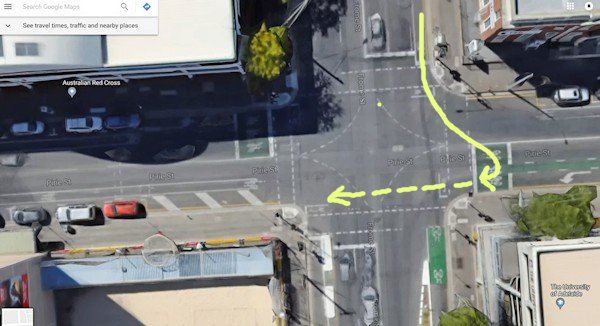
2. At lights, stay out of the invisible danger zones. In the image below, which is on one of my frequent commuting routes, the correct lane for me to be taking across Highway One is the blue arrow lane. If I arrive first at the lights, which is not unlikely in that location, what happens if I pull up on the edge of the lane where the red line is, to allow people along side? In the Google Maps image it appears there is a cement truck at the head of the queue. This, and semitrailers, are likely to hide me from traffic behind the truck so that I collect a close pass or, if I fall, am run over by a following motorist who has no idea I was there.
The correct place to stop is in the blue line, where I am clearly visible to the traffic behind me as I start. Once I am cleated in and stable, I can begin to move left to allow over taking. In the red spot, it is just possible that if the lights change at the right moment, I will be starting off as someone races past at 70kph.
A good stopping spot at an intersection like this one,if there are already vehicles queued, is just behind a truck. I sit mid lane, and use the truck's slow start to get stable and build up speed without delaying traffic behind me.
In any event, always stop based on what will give the most visibility if something goes wrong, and placed to discourage close squeeze-by passes while you are at your most unstable.
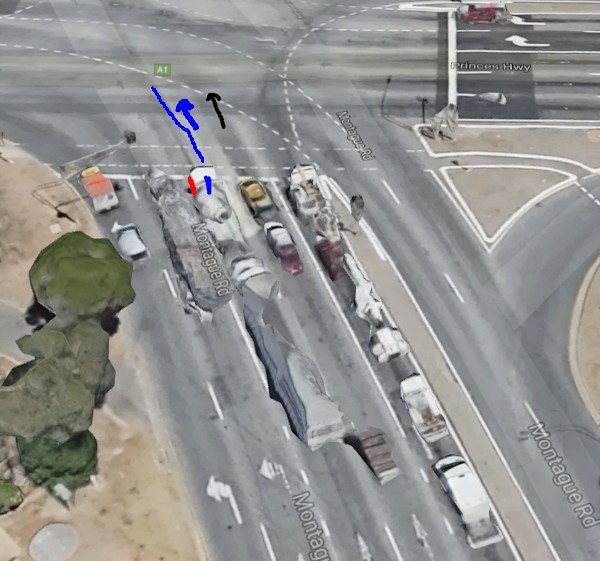
3. This route is an excellent commuting route because of the connections through to Mawson Lakes and because of the large number of professional, and mostly courteous, drivers who use Churchill Road North. But I see some appalling approaches taken by cyclists. They occur elsewhere, as well.
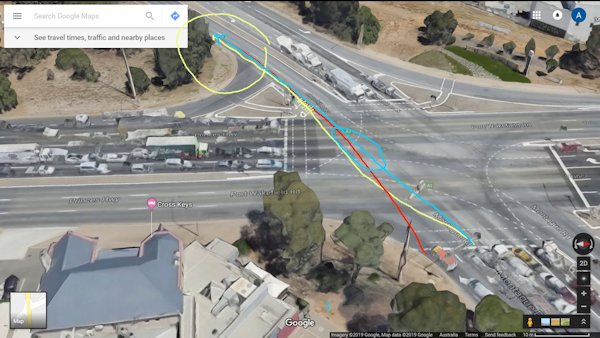
The red route asks for trouble. The bike is coming in from where no one should be, and is crossing two lanes turning left. Yellow starts in the correct lane, but then slides out of view in the mistaken view that this route is safer, ignoring the fact that it must re-enter the flow of traffic in an area where gravel and glass collect, (the yellow hatched area) and where drivers are often looking right to assess their opportunity to overtake. It invites squeeze-by passing. Both the red and yellow routes tend closer to the edge of the lane and toward being forced into the edge of the road in the area of the yellow circle. The blue route remains visible the whole time, and having started in the centre of the lane, is less prone to being cut off. A reasonably fit rider will reach at least the area of the blue ellipse before most traffic catches up with them, and be even further along before most trucks get near them. Obviously, one needs to stop and start in the correct gear!
If I found I was not able to get some way across before traffic from a standing stop, I might consider using pedestrian lights.
4. A key issue here is knowing how to clip in using muscle memory, or riding uncleated until we are across an intersection. There is nothing worse than a cyclist looking down at their pedal as they cross a road, instead of looking at the traffic!!!
5. Always be rolling before committing to a start across an uncontrolled intersection. in the situation below, we may instinctively seek to cross Churchill Road from Albert to Gur, by starting at the red cross. But this leaves no time to recover from any false starts or mistakes, and we are entering into the traffic flow at our most unstable. If we start 2 to 3 metres back, at the blue cross, two things happen. We are moving and stable as we enter the road, and if we have misjudged a car, or they have sped up at us, it is simple to swerve left into the bike path. We have what I call a "Plan B" escape route.
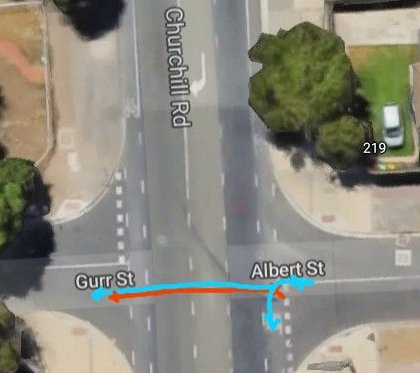
6. It's not often that I get to ride straight across this intersection during the day. It can mean a long wait. Because of the right turn lanes, there is another option we can use. The blue line shows how to use the turn lanes. From a rolling start I head slightly north and then turn sharp south in the turning lane. I may have the option to keep rolling as I face south. Otherwise (yellow), if I have needed to stop, I roll a little south to gain stability before turning across the traffic flow.
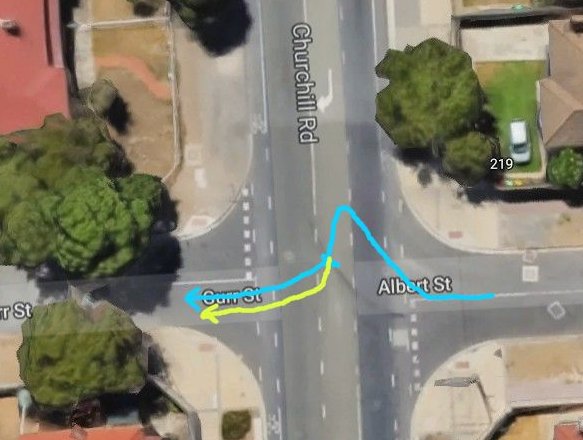
What this technique depends on is good turning control at low speed, and an assessment of the general traffic behaviour. By this point on Churchill Road the traffic is settled. It is usually fairly busy in both directions, and few people seek to overtake. So the right turn lane is a safe place to sit. Don't use this if a car is turning into the turn lane, because your behaviour will be unexpected and may cause them to swerve into traffic!
Sometimes it's just easier to dogleg across a busy road. If I take the road to the south of Albert Street, (Alexandra) I can dogleg into Kingdom Place and hit my road on the railway line, which is indicated by the yellow lines.
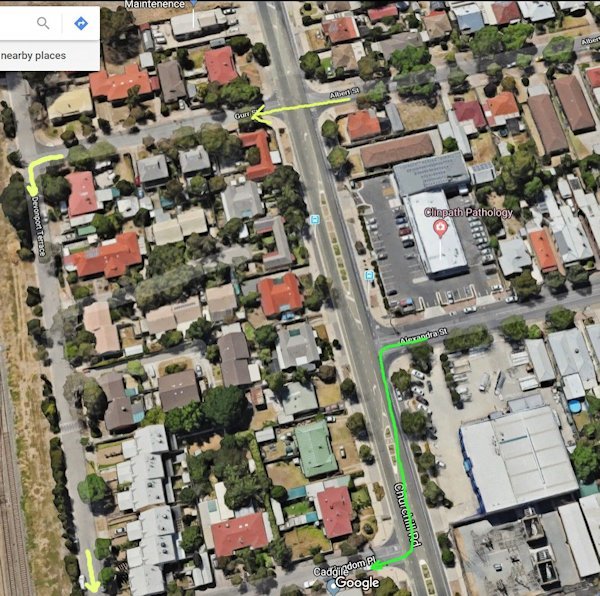
7. In some places it's just simpler to run the bike across the road. The one hazard is stopping mid crossing: the bike sticks out in front and behind us. It's not like jaywalking across a street.
8. I tend to look for routes with refuges. The Daws Road crossing is a good example.
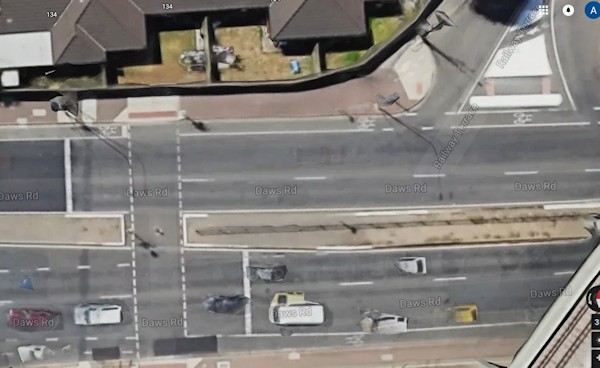
9. With all of these crossings, ride with a Plan B. Where will you go if things go pear shaped? Don't use "to the second timing"; it's too easy to misjudge a high speed idiot or someone who speeds up on purpose. Or just misjudge things so that we are the minority of cyclists who cause the crash.
The next post will be: Staying smooth.
